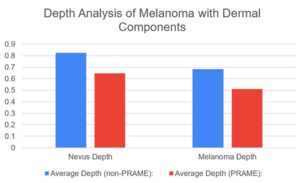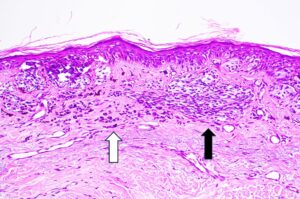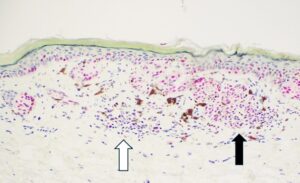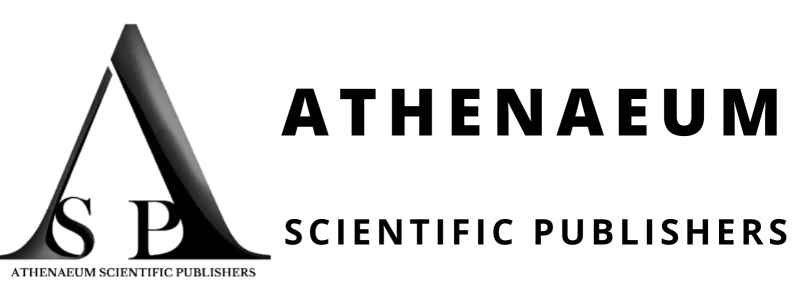Brevin McCool1, Antonio Ray2, Michael Hatch3, Cary Chisholm3*
1Lubbock Christian University, 5601 19th Street, Lubbock, TX 79407, USA
2William Carey University College of Osteopathic Medicine, 710 William Carey Pkwy, Hattiesburg, MS 39401, USA
3Epiphany Dermatology, 211 N. Industrial Drive, Waco, TX 76710, USA
*Correspondence author: Cary Chisholm, MD, Epiphany Dermatology, 211 N. Industrial Drive, Waco, TX 76710, USA;
Email: [email protected]
Published Date: 31-07-2024
Copyright© 2024 by McCool B, et al. All rights reserved. This is an open access article distributed under the terms of the Creative Commons Attribution License, which permits unrestricted use, distribution, and reproduction in any medium, provided the original author and source are credited.
Abstract
Background: PRAME immunohistochemistry has been reported to be positive in at least 83.2% of invasive melanomas while being positive in no more than 13.6% of benign nevi. Melanoma may arise within pre-existing nevi or dysplastic nevi and PRAME could potentially have an effect on the measured Breslow depth.
Objective: We performed a retrospective review of invasive melanoma cases diagnosed over a 4 year period to evaluate if the use of PRAME had an impact on Breslow depth.
Methods: Diagnostic reports were reviewed to separate out cases of invasive melanoma that arose in precursor nevi or dysplastic nevi. The final sample size is 152 cases.
Results: The average melanoma depth in the PRAME group was 0.51 mm, while being 0.68 mm in the no PRAME group (p<0.05). The pathologic stage was unchanged in all cases.
Limitations: The pathology reports were made by multiple dermatopathologists and therefore reporting of precursor nevi on the reports may not be entirely uniform.
Conclusion: PRAME does impact the Breslow depth of invasive melanoma when arising in precursor nevi, but significant alterations in the pathologic stage were not observed.
Keywords: PRAME; Melanoma; Breslow Depth; Precursor Nevi; Melanoma in a Nevus; Dermatopathology
Capsule Summary
- PRAME may often help with the diagnosis of melanoma, especially when arising in precursor nevi
- The Breslow depth was less in the cases that utilized PRAME, but the pathologic stage was unchanged. PRAME is useful to differentiate melanoma from precursor nevi without impacting treatment and prognosis
Introduction
PRAME (PReferentially expressed Antigen in MElanoma) is a useful biomarker being investigated in different cancers occurring in various body sites. There has been significant interest in PRAME expression in cutaneous melanoma after showing positivity in at least 83.2% of invasive melanomas versus no more than 13.6% in benign nevi of various types [1,2]. After these early reports, many laboratories began incorporating PRAME immunohistochemistry to aid in the diagnosis of melanomas. This has led to publication of proposed numerical scoring systems which include reporting the percentage of positive lesional melanocytes and describing the intensity of PRAME positivity [3,4].
Our laboratory made the PRAME immunohistochemical stain available to our dermatopathologists in 2020. Since PRAME is a useful ancillary test in the diagnosis of melanoma, we investigated the effect of incorporating PRAME immunohistochemistry in our workflow on the distinction between invasive melanoma or melanoma in-situ and precursor nevi or dysplastic nevi, when present. We also examined the average Breslow depth of lesions prior to the incorporation of PRAME and compared it to the Breslow depth of those that were measured after PRAME was available in our laboratory. A change in Breslow depth could impact the pathologic stage and have dramatic therapeutic implications.
Material and Methods
In this study, we analyzed the distribution of historical melanoma diagnoses (Melanoma in-situ vs malignant melanoma) from 2018 through 2022. We began utilizing PRAME immunohistochemistry in our laboratory in 2019. A total of 5210 invasive melanoma and melanoma in-situ pathology reports were retrieved from our pathology archives for this time period. These cases were grouped into four categories, “Melanoma,” “Melanoma arising in a nevus”, “Melanoma in-situ” and “Melanoma in-situ arising in a nevus”.
We defined these categories as seen below:
Melanoma
Invasive melanoma with malignant melanocytes present in the dermis.
Melanoma Arising in a Nevus
Invasive melanoma with two populations of melanocytes in the dermis – one malignant and one benign.
Melanoma In-situ
Non-invasive with a minimum of contiguous basal layer melanocytes in the epidermis. These lesions may also have melanocyte nests and upward scatter of melanocytes (Pagetoid spread) through the full thickness of the epidermis in addition to contiguous basal layer melanocytes.
Melanoma in-situ arising in a nevus- Melanoma in-situ with a population of dermal melanocytes showing benign characteristics.
These groups were then subdivided based on if the case was examined before or after the availability of PRAME immunohistochemistry. Those occurring before PRAME were designated as the “no PRAME” group and those occurring after PRAME were designated as the “PRAME” group. Demographic data and lesion site was also recorded for the “Melanoma arising in a nevus” category. Cases of “melanoma arising in a nevus” that were grouped into the “PRAME” group must demonstrate positive PRAME staining in the malignant melanocytes and negative staining in the benign population.
Results
Of the 5210 cases, there were 1556 melanoma, 230 melanoma arising in a nevus, 2821 melanoma in-situ and 603 melanoma in situ arising in a nevus. As stated above, these cases were then further classified as whether they were diagnosed before or after PRAME. For the purposes of this study, we then excluded all invasive melanoma cases that arose in conjunction with junctional nevi or dysplastic junctional nevi as these cases would have no bearing on the Breslow depth since there is an absence of benign melanocytes in the dermis in addition to the malignant melanocytes.
Removing these cases left us with a study population of 152 invasive melanoma cases that had precursor nevi with a benign dermal component. 107 specimens were grouped into the “PRAME” group and 45 specimens were separated into the “No PRAME” group. In both groups we measured the Breslow depth for both the invasive melanoma component and the precursor nevus. It was also noted whether the precursor nevus was deeper, shallower, or the same depth as the invasive melanoma. The average melanoma depth in the PRAME group was 0.51 mm, while being 0.68 mm in the no PRAME group (Fig. 1). For this comparison, the t-value was calculated to be -1.94798 with a p-value of 0.026642; this result is significant at p <0.05. Demographic and lesion site data can be viewed in Tables 1 and 2.
We compared the average Breslow depths of benign nevi components. Average nevus depth was 0.64 mm in the PRAME group and 0.83 mm in the no PRAME group. The t-value was calculated to be -2.13946, with a p-value of 0.017; this result is significant at p <0.05. When comparing the benign nevi to the invasive melanoma in each group, 63.6% (N=68) of lesions in the PRAME group had nevi of greater depth than the melanoma versus 48.9% (N=22) of lesions in the no PRAME group. 9.3% (N=10) of the PRAME group had demonstrably smaller associated nevi versus 26.7% (N=12) in the no PRAME group.
We also compared the percentage of lesions with a diagnosed precursor benign compound nevus or compound dysplastic nevus against the total number of melanoma cases with any intradermal component before and after the implementation of PRAME. The intradermal component was more likely to be called a benign nevus or dysplastic nevus in the PRAME group (43.09%) than in the no PRAME group (26.04%). A chi-squared goodness-of-fit test was used with a resultant p-value of <0.001.
In regard to the melanoma in-situ group for this time period, 1096 cases were from before PRAME and 1725 cases were diagnosed after PRAME. There were 603 cases that mentioned a precursor nevus or dysplastic nevus on the pathology report, 216 from before PRAME and 387 after PRAME. Therefore, a precursor nevus or dysplastic nevus was noted in 16.4% of MIS cases prior to PRAME and 18.3% of cases after PRAME.
Discussion
PRAME has become a useful adjunct for the diagnosis of melanoma in some cases [5,6]. There are certain variants of melanoma, such as desmoplastic melanoma, with a poor rate of PRAME positivity as compared to other variants [7]. While positivity is not diagnostic for melanoma in-and-of-itself, it can help tilt the balance in cases when the morphological features and other ancillary stains may not give an unequivocally malignant pattern [8]. Other studies have shown that PRAME can be effectively utilized to differentiate between the benign and malignant components when melanoma arises in precursor nevi [9]. PRAME has also been shown to be a tool which can potentially alter practice patterns beyond just the diagnosis of melanoma, such as helping to evaluate surgical margins in excision cases [10].
PRAME is not a perfect method for diagnosing melanoma. It has been shown to have variable expression in benign and dysplastic nevi, although typically with a smaller percentage of positive lesional melanocytes that also display less intense staining [11,12]. Uncommonly, it may also be positive in histologic mimics of melanoma in-situ such as extramammary Paget’s disease and pagetoid squamous cell carcinoma in-situ [13]. However, it can help distinguish melanoma in-situ from inflammatory pseudonests [14].
We investigated whether the addition of PRAME into our practice had a meaningful influence on the depth of melanoma when arising within pre-existing dysplastic nevi or benign nevi. There are many instances where the intradermal melanocytes of precursor nevi are small, well-nested and nevoid while the invasive melanoma cells are large, poorly-nested and pleomorphic, making the distinction between the two straightforward. Cases with this type of contrast do not typically need PRAME to differentiate between the two components of the lesion. However, in cases where the intradermal melanocytes showed multiple different cytologic and architectural patterns (Fig. 2,3) or if the dermal component is largely nevoid throughout, we have found PRAME to be useful in confirming whether all the components represented invasive melanoma. In these cases, this finding was often supported by other immunohistochemical evidence, such as absent stratification with HMB-45.
As a departmental policy, all melanoma in-situ and invasive melanoma is confirmed by two board-certified dermatopathologists. Interestingly, despite this double-check, the addition of PRAME was associated with a more frequent diagnosis of precursor nevi in these lesions, p<0.001 and the average depth of melanoma decreased, p<0.05. While the mean Breslow depth decreased in our PRAME group in a statistically significant manner, it did not affect the pathologic stage in any of our cases.

Figure 1: Comparison of melanoma and precursor nevus depth with and without PRAME.
Total Number of Cases | PRAME + | No PRAME |
Male | 72 | 28 |
Female | 35 | 17 |
Age Range | ||
Overall | 24-98 yrs | 22-85 yrs |
Male | 26-98 yrs | 22-85 yrs |
Female | 24-89 yrs | 31-80 yrs |
Number of Cases by Site | ||
Arm/Shoulder | 28 | 10 |
Chest | 6 | 2 |
Back | 34 | 19 |
Abdomen | 7 | 2 |
Legs | 16 | 4 |
Head/Neck | 16 | 8 |
Table 1: Demographic data for all lesions.
Site with Lesion Type | PRAME + | No PRAME | ||
Male (mm) | Female (mm) | Male (mm) | Female (mm) | |
Arm/Shoulder | ||||
Nevus | 0.49 | 0.58 | 0.67 | 0.73 |
Melanoma | 0.39 | 0.45 | 0.76 | 0.68 |
Chest | ||||
Nevus | 0.45 | 0.35 | 0.5 | 0.9 |
Melanoma | 0.28 | 0.31 | 0.65 | 0.81 |
Back | ||||
Nevus | 0.61 | 0.78 | 0.66 | 1 |
Melanoma | 0.46 | 0.66 | 0.78 | 0.48 |
Abdomen | ||||
Nevus | 0.48 | 0.3 | 0.6 | 0.6 |
Melanoma | 0.4 | 0.4 | 0.58 | 0.32 |
Legs | ||||
Nevus | 0.81 | 0.89 | 0.53 | 0.8 |
Melanoma | 0.45 | 0.74 | 0.55 | 0.27 |
Head/Neck | ||||
Nevus | 0.85 | 0.68 | 1.7 | 0.8 |
Melanoma | 0.81 | 0.48 | 0.54 | 1 |
Table 2: Average Breslow depth of melanoma and precursor nevus organized by site and gender.

Figure 2: Two distinct populations of dermal melanocytes are present: 1- nevoid melanocytes with single-file pattern (white arrow) and 2- nested, spindled melanocytes (black arrow) (H&E, 20x).

Figure 3: PRAME staining is positive in the nested, spindled melanocytes (black arrow), but negative in the nevoid, single-file melanocytes (white arrow) (20x).
Conclusion
This study indicates that incorporation of PRAME immunohistochemistry into a dermatopathologist’s normal workflow may impact the measured Breslow depth of melanoma in the presence of a pre-existing nevus and therefore potentially impact treatment and prognosis. Incorporation of PRAME immunohistochemistry may additionally influence the tendency of pathologists to designate a dermal population of melanocytes, occurring in conjunction with melanoma or melanoma in-situ, as a pre-existing nevus. Further studies may be warranted to validate such a clinical impact.
Conflict of Interests
The authors declare that there is no conflict of interest for this paper.
Funding Sources
None
IRB Approval Status
Not needed since this is not active research on human subjects and is a historical analysis. No identifiable information is used.
Patient Consent on File
Not applicable.
Reprint Requests
Cary Chisholm, M.D.
References
- Raghavan SS, Wang JY, Kwok S, Rieger KE, Novoa RA, Brown RA. PRAME expression in melanocytic proliferations with intermediate histopathologic or spitzoid features. J Cutan Pathol. 2020;47(12):1123-31.
- Lezcano C, Jungbluth AA, Nehal KS, Hollmann TJ, Busam KJ. PRAME Expression in Melanocytic Tumors. Am J Surg Pathol. 2018;42(11):1456-65.
- O’Connor MK, Dai H, Fraga GR. PRAME immunohistochemistry for melanoma diagnosis: A STARD-compliant diagnostic accuracy study. J Cutan Pathol. 2022;49(9):780-6.
- Cazzato G, Cascardi E, Colagrande A, Belsito V, Lospalluti L, Foti C, et al. PRAME Immunoexpression in 275 Cutaneous Melanocytic Lesions: A Double Institutional Experience. Diagnostics (Basel). 2022;12(9):2197.
- Alomari AK, Tharp AW, Umphress B, Kowal RP. The utility of PRAME immunohistochemistry in the evaluation of challenging melanocytic tumors. J Cutan Pathol. 2021;48(9):1115-23.
- Kunc M, Żemierowska N, Skowronek F, Biernat W. Diagnostic test accuracy meta-analysis of PRAME in distinguishing primary cutaneous melanomas from benign melanocytic lesions. Histopathology. 2023;83(1):3-14.
- Googe PB, Flanigan KL, Miedema JR. Preferentially expressed antigen in melanoma immunostaining in a series of melanocytic neoplasms. Am J Dermatopathol. 2021;43(11):794-800.
- Harvey NT, Peverall J, Acott N, Mesbah Ardakani N, Leecy TN, Iacobelli J, et al. Correlation of FISH and PRAME immunohistochemistry in ambiguous superficial cutaneous melanocytic proliferations. Am J Dermatopathol. 2021;43(12):913-20.
- Lohman ME, Steen AJ, Grekin RC, North JP. The utility of PRAME staining in identifying malignant transformation of melanocytic nevi. J Cutan Pathol. 2021;48(7):856-62.
- Gradecki SE, Valdes-Rodriguez R, Wick MR, Gru AA. PRAME immunohistochemistry as an adjunct for diagnosis and histological margin assessment in lentigo maligna. Histopathology. 2021;78(7):1000-8.
- Turner N, Ko CJ, McNiff JM, Galan A. Pitfalls of PRAME immunohistochemistry in a large series of melanocytic and nonmelanocytic lesions with literature review. Am J Dermatopathol. 2024;46(1):21-30.
- Innocenti L, Scarpitta R, Corraro S, Ortenzi V, Bonadio AG, Loggini B, et al. Shedding light on PRAME expression in dysplastic nevi: a cohort study. Virchows Arch. 2023.
- Chisholm C, Hatch M, Post S, Chain S. PRAME expression in mimickers of melanoma in-situ: paget’s disease, extramammary paget’s disease and pagetoid squamous cell carcinoma in-situ. Int J Pathol Clin Res. 2022;8:135.
- Roy SF, Panse G, McNiff JM. PRAME immunohistochemistry can distinguish melanocytic pseudonests of lichenoid reactions from melanoma in-situ. J Cutan Pathol. 2023;50(5):450-4.
Article Type
Research Article
Publication History
Received Date: 01-07-2024
Accepted Date: 24-07-2024
Published Date: 31-07-2024
Copyright© 2024 by McCool B, et al. All rights reserved. This is an open access article distributed under the terms of the Creative Commons Attribution License, which permits unrestricted use, distribution, and reproduction in any medium, provided the original author and source are credited.
Citation: McCool B, et al. The Impact of PRAME Expression on Breslow Depth in Melanoma Arising in Dysplastic Nevi in a Large Multi-State Dermatology Group. J Dermatol Res. 2024;5(2):1-7.

Figure 1: Comparison of melanoma and precursor nevus depth with and without PRAME.

Figure 2: Two distinct populations of dermal melanocytes are present: 1- nevoid melanocytes with single-file pattern (white arrow) and 2- nested, spindled melanocytes (black arrow) (H&E, 20x).

Figure 3: PRAME staining is positive in the nested, spindled melanocytes (black arrow), but negative in the nevoid, single-file melanocytes (white arrow) (20x).


